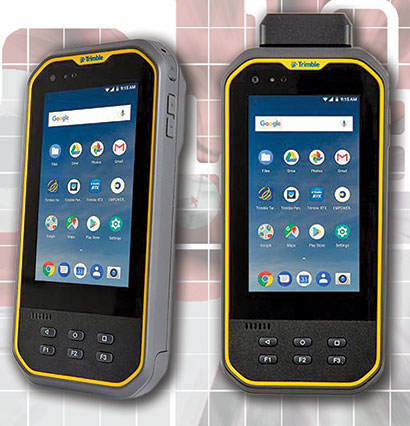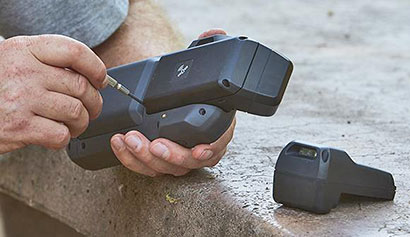|
Trimble Nomad 5
The next-gen Nomad is all Android now, better and faster in every respect, and as tough as ever,
(by Conrad H. Blickenstorfer)
Trimble introduced the Nomad 5 handheld computer October 2018 as the next generation of its time-tested series of rugged Nomad handhelds. Built for tasks such as data collection, asset management and inspections, the Nomad 5 is designed to help professional field teams conduct their work with maximum productivity and efficiency.

Trimble Nomad data collection handhelds have been around for over a decade. Their looks, hardware and software changed over time, but the Nomad's concept hasn't. Trimble knows how to build tough tools for the job, stuff that doesn't break or fail. The new Nomad 5 is certain to continue that tradition.
What is the Trimble Nomad?
The Nomad is a rugged handheld computer designed for people who work outdoors. It is built to take the kind of abuse that can happen in the field: dust, water, drops, vibration and so on. It is also built to run for a long time on a single charge, and to accommodate a variety of connections and peripherals. A computer that can handle all that is not going to be as thin and light as a smartphone, and the Nomad isn't. It has a substantial footprint of 7.9 x 3.76 inches and weighs over a pound and a half. It's also several times as thick as a modern smartphone, and that's because it's almost infinitely tougher than any consumer phone.
Like Trimble's other mobile computers, the Nomad 5 sports a utilitarian but ruggedly handsome design born of a few very simple tenets. A virtually invulnerable shell protects the electronics inside. A module bay allows extensive customization. The device is built to operate in extreme temperatures and survive drops, vibration, altitude, corrosives, dust and more. It's impervious to dust and liquids, and even full immersion.
What also sets the Nomad 5 apart is that it's from Trimble, the US$2.7 billion (2017) positioning technology specialists known for their GPS and other measuring hardware and software used worldwide. For Trimble, GPS is not just a feature. It is the feature (the Nomad 5 can achieves sub-meter positioning when paired with the Trimble R1 GNSS receiver or the Trimble EMPOWER GNSS receiver module).
What new for the Nomad 5 Series?
Just like rugged computing tools for the job do not compete with consumer electronics in terms of the latest fashion trends, they also have different criteria when it comes to technology. The latest buzzword technology matters less than having wide developer support, offering easy configuration and customization, supporting legacy protocols, and just generally getting the job done.
What has changed is that the Nomad — which had started as a rugged Windows Mobile Pocket PC back in 2007 when the iPhone was first announced — is now an Android device. With Microsoft having given up on handheld operating systems, there's no more need for manufacturers to hedge their bets and support both Windows and Android. It's all Android now, and that means a quick Qualcomm SnapDragon 820 chip with Adreno 530 graphics.
For storage, the new Nomad 5 comes with 4GB of RAM, and 32GB of non-volatile Flash storage (plus SD card storage). There's worldwide LTE mobile broadband (if available in a region) that's compatible with 3G networks. goes up from GSM/GPRS/EDGE to 3.75G GSM/CDMA. There's a Ublox NEO-M8T chipset that does GPS, GLONASS and Beidou and supports both raw-data output for postprocessing and an external antenna. There's an 8MP camera in front and a 16MP autofocus camera with LED flash in the rear. There are all the sensors common to modern handhelds.
The display has grown substantially from earlier Nomads; it now measures 5 inches diagonally, sports sharp 294 ppi resolution, and is very bright (830 nits). And, of course, it's now capacitive multi-touch. As for the battery, it packs a full 35 watt-hours, good for several shifts.
Expansion and models
Almost unlimited expansion potential has always been an inherent strength of Trimble's Nomad handhelds. Early versions had both a SDIO slot for extra data storage and a CompactFlash Type II slot for expansion. Later models offered expansion via USB port and end caps that could support expansion modules.

On the Nomad 5, expansion and customization is via Trimble EMPOWER modules (the same as those for the Trimble TSC7 survey controller and the Trimble Ranger 7 handheld) that can add RFID/barcode reading, sub-meter L1/L-Band GNSS or custom functionality.
Bottom Line: Trimble Nomad 5
When we did a hands-on review of the original Nomad back in 2007 we wrote that it ranked "right up there with the best conceived, designed, and most meticulously executed rugged handhelds we've tested." That remains true more than a decade later. The latest Trimble Nomad, again, seems a superb industrial design that is ergonomic, attractive and functional.
While consumer smartphone and industrial handheld computer technologies have diverged in recent years, the invulnerable Nomad remains an eminently practical, powerful handheld computer for surveying, mapping, scanning, communicating, and data capture. The applications are endless, and no matter where the machine is deployed, it can handle any abuse that comes its way. -- Conrad H. Blickenstorfer, November 2018
|



